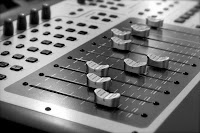Reader
Jim Yeomans requested a song analysis of the
Fall Out Boy hit "
My Songs Know What You Did In The Dark," which is from their 5th studio album entitled
Save Rock And Roll. The song was a worldwide hit, reaching the top 5 in the US on
iTunes and in singles charts in the UK, Scotland and Ireland. As with all song analysis, we'll look at the song from, the arrangement, the sound and the production.
The Song
"My Songs Know What You Did In The Dark" has a fairly simple form of intro, verse and chorus with no bridge or solo. As a result it clocks in at only 3:11, a timing that's built for radio, which loves the short song (and even speeds many songs up in order to play more songs per hour).
The form looks like this:
Intro, Verse, B section, Chorus, Verse,
B section, Chorus, B section (2x), Chorus, Tag
What's unusual about the form is that the title of the song appears in the 4 bar B section. The song is built around a single chord pattern, and that limits the melody somewhat, but there's still a melody there, which is more than you can say about many songs these days. Likewise, the lyrics work fairly well within the context of the song, telling a story and rhyming well without seeming forced.
The Arrangement
When a song is built around a single riff, chord or chord pattern, it needs a great arrangement to succeed. So is the case with "My Songs Know What You Did In The Dark." The arrangement elements looks like this:
* The Foundation: bass and drums, vocal loops
* The Rhythm: vocal loops, rhythm guitars, claps, synth line
* The Pad: none
*The Lead: lead vocal
* The Fills: vocals, effects
The song begins with a vocal loop and claps for 4 bars, after which a second vocal loop enters along with the drums for four bars, and then an electric guitar for the next four bars to complete the intro.
The first verse sees the lead vocal enter as well as a 16th note bass following the chord pattern. A sound effect occurs after the first two phrases then again after the fifth and sixth. The drums fall out during the B section when the title lyrics are stated, which leads into the big chorus with the drums switching to a half-time feel. On bar 5 "hey's" enter on the upbeat of beat 4, then on the second half of the chorus, the "whoa's" are answered by "I'm on fire" along with a new single note synth line, and then with an "In the dark, dark" vocal sample at the end of each chord pattern.
On the second verse a synth is added behind the sound effects, and a floor tom enters on bar 5. The band drops out completely on bar 12 except for a lighter sound effect. The second chorus is almost identical to the first, but with the addition of some bigger sounding guitars.
The song then returns to the opening 4 bars of the intro with the addition of some very reverbed out "hey's", then to a standard B section that's repeated, only with a very lo-fi vocal. The last chorus is bigger than the previous 2 thanks to additional parts. The song ends with a 2 bar tag of "whoa's" without any music.
The Sound
While the trend in mixing was to keep everything dry for a long time, but "My Songs Know What You Did In The Dark" shows what seems to be a new trend back to layered effects. Each vocal loop has a different reverb, as does the snare and the sound effects. The vocal uses a stereo tape delay simulation (you can tell by how it gets fuzzy and dull as it repeats), which is also somewhat of a trend these days.
The song is very compressed and borderline distorted, and I wonder just how much better it would've sounded if there were some dynamics left in it.
The Production
As stated before, when a song is built around a single riff, chord or chord pattern, it needs a great arrangement, as well as great production to succeed. "My Songs Know What You Did In The Dark" is pretty cool from the standpoint that there's always something new going on as you go through the song. There's either a new sound effect or a new vocal loop in every vocal hole, the song's intensity changes, or a different reverb or echo can be heard.
What's also cool is the unusual drum beat in the intro and verses that then changes to a half-time feel during the big choruses. What's also unusual is that for a guitar band, the guitars aren't featured in the song. Of course, add all of the above together and you have a hit.
Send me your song requests for analysis (no originals, only hits) at "requests at bobbyowsinski.com."
----------------------------------



